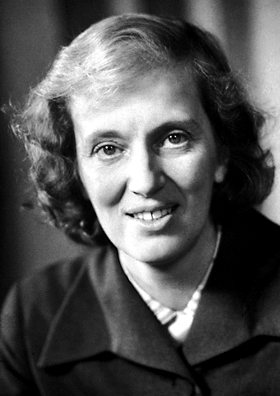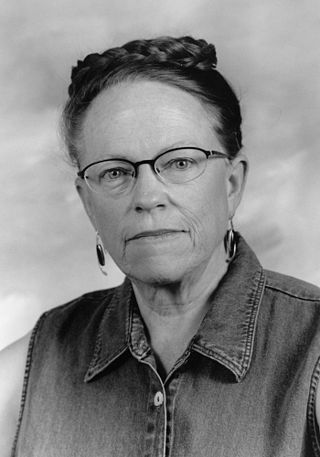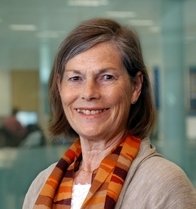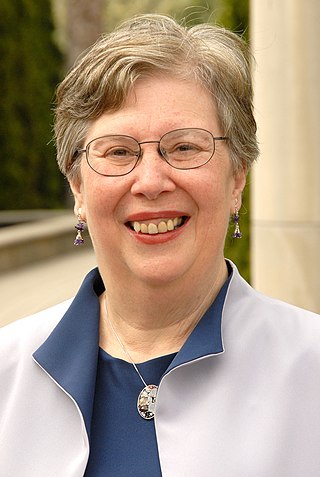
X-ray crystallography is the experimental science determining the atomic and molecular structure of a crystal, in which the crystalline structure causes a beam of incident X-rays to diffract into many specific directions. By measuring the angles and intensities of these diffracted beams, a crystallographer can produce a three-dimensional picture of the density of electrons within the crystal. From this electron density, the positions of the atoms in the crystal can be determined, as well as their chemical bonds, crystallographic disorder, and various other information.

Dorothy Mary Crowfoot Hodgkin was a Nobel Prize-winning English chemist who advanced the technique of X-ray crystallography to determine the structure of biomolecules, which became essential for structural biology.

Lawrence James DeLucas is an American biochemist who flew aboard NASA Space Shuttle mission STS-50 as a Payload Specialist. He was born on July 11, 1950, in Syracuse, New York, and is currently married with three children. His recreational interests include basketball, scuba diving, bowling, model airplanes, astronomy and reading.
The Henderson limit is the X-ray dose (energy per unit mass) a cryo-cooled crystal can absorb before the diffraction pattern decays to half of its original intensity. Its value is defined as 2 × 107 Gy (J/kg).
M. R. N. Murthy, was a professor of molecular biophysics at the Indian Institute of Science, IISc, Bangalore. He currently teaches at the Institute of Bioinformatics and Applied Biotechnology, Bengaluru. His chief contributions are in the area of X-ray crystallography. He was awarded the Shanti Swarup Bhatnagar award for outstanding contribution to physical sciences, which is the highest honour for a scientist in India, in the year 1992.

Jane Shelby Richardson is an American biophysicist best known for developing the Richardson diagram, or ribbon diagram, a method of representing the 3D structure of proteins. Ribbon diagrams have become a standard representation of protein structures that has facilitated further investigation of protein structure and function globally. With interests in astronomy, math, physics, botany, and philosophy, Richardson took an unconventional route to establishing a science career. Richardson is a professor in biochemistry at Duke University.

Dame Louise Napier Johnson,, was a British biochemist and protein crystallographer. She was David Phillips Professor of Molecular Biophysics at the University of Oxford from 1990 to 2007, and later an emeritus professor.
Axel T. Brunger is a German American biophysicist. He is Professor of Molecular and Cellular Physiology at Stanford University, and a Howard Hughes Medical Institute Investigator. He served as the Chair of the Department of Molecular and Cellular Physiology (2013–2017).
Acta Crystallographica is a series of peer-reviewed scientific journals, with articles centred on crystallography, published by the International Union of Crystallography (IUCr). Originally established in 1948 as a single journal called Acta Crystallographica, there are now six independent Acta Crystallographica titles:

Helen Miriam Berman is a Board of Governors Professor of Chemistry and Chemical Biology at Rutgers University and a former director of the RCSB Protein Data Bank. A structural biologist, her work includes structural analysis of protein-nucleic acid complexes, and the role of water in molecular interactions. She is also the founder and director of the Nucleic Acid Database, and led the Protein Structure Initiative Structural Genomics Knowledgebase.
Eleanor Joy Dodson FRS is an Australian-born biologist who specialises in the computational modelling of protein crystallography. She holds a chair in the Department of Chemistry at the University of York. She is the widow of the scientist Guy Dodson.

Mamannamana Vijayan was an Indian structural biologist.

Professor Jennifer Louise "Jenny" Martin is an Australian scientist and academic. She was the Deputy Vice-Chancellor at the University of Wollongong, in New South Wales from 2019-2022. She is a former Director of the Griffith Institute for Drug Discovery at Griffith University. and a former Australian Research Council Laureate Fellow at the Institute for Molecular Bioscience, University of Queensland. Martin is an Honorary Professor at the University of Queensland and Adjunct Professor at Griffith University. Her research expertise encompasses structural biology, protein crystallography, protein interactions and their applications in drug design and discovery.

Jenny Pickworth Glusker is a British biochemist and crystallographer. Since 1956 she has worked at the Fox Chase Cancer Center, a National Cancer Research Institute in the United States. She was also an adjunct professor of biochemistry and biophysics at the University of Pennsylvania.
Krystle McLaughlin is a Caribbean-American structural biophysicist. She is an assistant professor of chemistry at Vassar College.
Microcrystal electron diffraction, or MicroED, is a CryoEM method that was developed by the Gonen laboratory in late 2013 at the Janelia Research Campus of the Howard Hughes Medical Institute. MicroED is a form of electron crystallography where thin 3D crystals are used for structure determination by electron diffraction. Prior to this demonstration, macromolecular (protein) electron crystallography was only used on 2D crystals, for example.

Barbara Wharton Low was a biochemist, biophysicist, and a researcher involved in discovering the structure of penicillin and the characteristics of other antibiotics. Her early work at Oxford University with Dorothy Hodgkin used X-ray crystallography to confirm the molecular structure of penicillin, which at the time was the largest molecule whose structure has been determined using that method. Later graduate work saw her study with Linus Pauling and Edwin Cohn before becoming a professor in her own right. Low's laboratory would accomplish the discovery of the pi helix, investigate the structure of insulin, and conduct research into neurotoxins.

Władysław Minor also known as Wladek Minor is a Polish-American biophysicist, a specialist in structural biology and protein crystallography. He is a Harrison Distinguished Professor of Molecular Physiology and Biological Physics at the University of Virginia. Minor is a co-author of HKL2000/HKL3000 – crystallographic data processing and structure solution software used to process data and solve structures of macromolecules, as well as small molecules. He is a co-founder of HKL Research, a company that distributes the software. He is also a co-author of a public repository of diffraction images (proteindiffraction.org) for some of the protein structures available in the Protein Data Bank and other software tools for structural biology.
John R. Helliwell is a British crystallographer known for his pioneering work in the use of synchrotron radiation in macromolecular crystallography.











